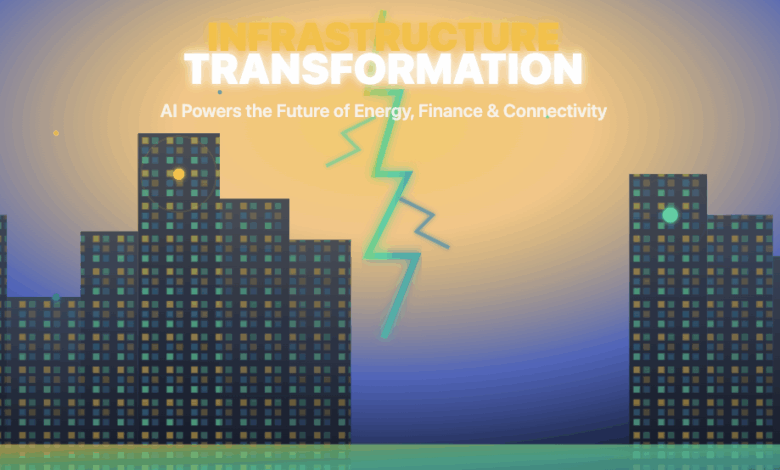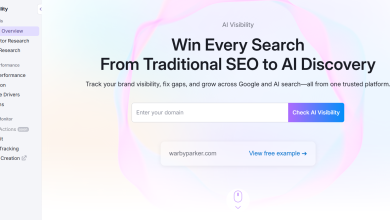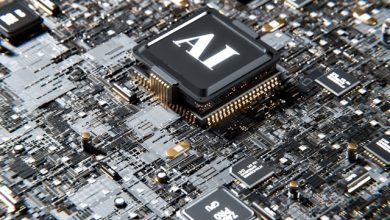
The central thesis: We are witnessing the beginning of the most significant infrastructure transformation in decades. Artificial intelligence isn’t simply optimizing existing systems—it’s enabling entirely new approaches that bypass traditional infrastructure constraints. By 2030, competitive advantage will increasingly belong to organizations that embrace AI-native infrastructure strategies alongside traditional approaches.
Beyond Optimization: AI as Infrastructure Foundation
Traditional infrastructure development has followed established patterns: identify inefficiencies, invest capital, upgrade systems, measure improvements. While this approach has driven progress for decades, AI introduces fundamentally different possibilities that extend far beyond incremental optimization.
The strategic opportunity lies in recognizing AI not merely as another tool for improving existing systems, but as the foundation for entirely new infrastructure approaches. This shift in perspective opens possibilities that were previously impossible within traditional frameworks.
Consider the mathematical reality: AI-native energy systems can manage complexity across millions of variables simultaneously, enabling renewable integration and grid stability at levels that exceed traditional system capabilities. AI-driven financial platforms can create sophisticated services without requiring the extensive physical infrastructure that traditional banking depends upon.
This represents a profound expansion of what’s possible, creating new pathways for infrastructure development that complement and, in many cases, surpass traditional approaches.
The Leapfrogging Opportunity: When New Beats Established
One of the most significant strategic insights emerging from AI infrastructure development is the advantage of starting fresh versus upgrading existing systems. Markets and organizations without extensive legacy infrastructure often find it easier to implement AI-native solutions that deliver superior performance.
Energy systems designed from the ground up with AI integration can achieve renewable integration levels and grid efficiency that retrofitted traditional systems struggle to match. This creates opportunities for rapid deployment of clean energy solutions in markets previously considered challenging.
Financial systems built on AI foundations can serve populations that traditional banking infrastructure cannot reach economically. These platforms create new models for financial inclusion that expand markets rather than simply optimizing existing ones.
Connectivity infrastructure optimized by AI can deliver advanced services with significantly less physical investment than traditional network expansion requires. This enables rapid deployment of digital services in underserved markets.
Organizations that understand this dynamic can identify opportunities to implement AI-native solutions that achieve better outcomes with more efficient resource utilization.
The Clean Energy Transformation: AI as the Integration Engine
The intersection of AI and clean energy represents one of the most compelling infrastructure transformation opportunities available today. Traditional clean energy deployment faces fundamental challenges around intermittency, grid integration, and demand management. AI addresses these challenges while simultaneously creating new possibilities.
AI enables energy systems to dynamically integrate renewable sources, predict demand patterns with unprecedented accuracy, and optimize storage and distribution across complex networks. More importantly, it can do this while managing multiple objectives—cost, reliability, environmental impact—simultaneously rather than requiring trade-offs between them.
The implications extend beyond efficiency improvements. AI-optimized energy systems can achieve grid stability with renewable integration levels that traditional systems cannot handle. They can optimize energy storage and distribution in real-time, creating resilience and efficiency that transforms the economics of clean energy deployment.
This transformation is already occurring at scale. Energy companies are using AI to generate significant value while reducing carbon emissions by millions of tonnes. The technology’s optimizing capability helps improve energy efficiency while simultaneously managing its own environmental footprint.
The Financial Evolution: New Models for Global Inclusion
The financial services sector demonstrates how AI enables new approaches to longstanding challenges. Traditional banking infrastructure assumes physical presence, established credit
histories, and regulatory frameworks designed around centralized institutions. AI creates alternatives that expand access while maintaining security and functionality.
AI can assess creditworthiness through alternative data sources, including behavioral patterns, communication history, and transaction data from digital platforms. This enables financial service delivery to populations that traditional systems cannot serve profitably, expanding markets rather than simply optimizing existing customer relationships.
These new approaches are already delivering results at significant scale. Financial platforms using AI for risk assessment have extended services to millions of people in underserved markets, creating economic opportunities while maintaining appropriate risk management.
The strategic insight is that AI enables financial services to be delivered through existing communication and transaction platforms, reducing the infrastructure requirements for market entry while potentially improving user experience and accessibility.
The Connectivity Revolution: Intelligence Over Infrastructure
Traditional telecommunications development assumes comprehensive physical infrastructure coverage as a prerequisite for advanced services. AI creates new possibilities for delivering sophisticated connectivity solutions with more efficient infrastructure utilization.
AI-optimized networks can adapt dynamically to demand patterns, route around failures automatically, and deliver advanced services without requiring the massive capital investments that traditional comprehensive coverage models demand. This enables rapid deployment of digital services in markets where traditional infrastructure development would be economically challenging.
The pattern is clear across multiple markets: mobile systems bypassed landline networks, mobile payments created new financial service models, and mobile-first digital services enabled advanced connectivity without comprehensive traditional infrastructure.
This pattern accelerates with AI, which can optimize network performance, predict demand, and manage resources in ways that dramatically improve the efficiency of infrastructure investments while expanding service capabilities.
Business Model Evolution: From Assets to Intelligence
The shift toward AI-native infrastructure creates new business model possibilities that complement traditional asset-based approaches. While traditional infrastructure companies build value through asset ownership and operational efficiency, AI-enabled models can build value through intelligence capabilities and network effects.
This creates different competitive dynamics and scaling possibilities. Intelligence-based models can expand into new markets with lower capital requirements, adapt to changing conditions more rapidly, and improve automatically through increased usage and data collection.
The strategic opportunity lies in developing hybrid approaches that combine the stability of traditional infrastructure assets with the scalability and adaptability of AI-driven intelligence systems.
The Policy Evolution: Enabling Innovation While Managing Risk
Current regulatory frameworks were designed around traditional infrastructure models and established industry structures. AI infrastructure development requires new approaches that enable innovation while appropriately managing risks.
The most successful implementations emerge from proactive engagement with regulators to develop frameworks that encourage beneficial applications while addressing legitimate concerns around security, privacy, and system stability.
This represents an opportunity for industry leadership in shaping regulatory approaches that enable AI infrastructure development while maintaining appropriate oversight and protection for users and markets.
The Talent Transformation: New Skills for New Systems
The evolution toward AI-enhanced infrastructure requires different skill sets than traditional infrastructure development. Organizations need capabilities in system design, data analysis, and AI implementation alongside traditional engineering and operational expertise.
The most valuable skill becomes the ability to identify where AI can enable entirely new approaches rather than simply improving existing processes. This requires understanding both AI capabilities and infrastructure needs in ways that create innovative solutions.
Successful organizations are investing in developing these hybrid capabilities while maintaining their existing operational expertise, creating teams that can bridge traditional infrastructure knowledge with AI implementation capabilities.
The Investment Landscape: Capital Flows and Strategic Priorities
Investment patterns are shifting toward AI-enhanced infrastructure approaches as the performance advantages and scalability benefits become clear. Traditional infrastructure investments remain important while AI-enabled alternatives create new opportunities for superior outcomes.
This creates different competitive dynamics and scaling possibilities. Intelligence-based models can expand into new markets with lower capital requirements, adapt to changing conditions more rapidly, and improve automatically through increased usage and data collection.
The strategic opportunity lies in developing hybrid approaches that combine the stability of traditional infrastructure assets with the scalability and adaptability of AI-driven intelligence systems.
The Policy Evolution: Enabling Innovation While Managing Risk
Current regulatory frameworks were designed around traditional infrastructure models and established industry structures. AI infrastructure development requires new approaches that enable innovation while appropriately managing risks.
The most successful implementations emerge from proactive engagement with regulators to develop frameworks that encourage beneficial applications while addressing legitimate concerns around security, privacy, and system stability.
This represents an opportunity for industry leadership in shaping regulatory approaches that enable AI infrastructure development while maintaining appropriate oversight and protection for users and markets.
The Talent Transformation: New Skills for New Systems
The evolution toward AI-enhanced infrastructure requires different skill sets than traditional infrastructure development. Organizations need capabilities in system design, data analysis, and AI implementation alongside traditional engineering and operational expertise.
The most valuable skill becomes the ability to identify where AI can enable entirely new approaches rather than simply improving existing processes. This requires understanding both AI capabilities and infrastructure needs in ways that create innovative solutions.
Successful organizations are investing in developing these hybrid capabilities while maintaining their existing operational expertise, creating teams that can bridge traditional infrastructure knowledge with AI implementation capabilities.
The Investment Landscape: Capital Flows and Strategic Priorities
Investment patterns are shifting toward AI-enhanced infrastructure approaches as the performance advantages and scalability benefits become clear. Traditional infrastructure investments remain important while AI-enabled alternatives create new opportunities for superior outcomes.
Traditional infrastructure optimization often requires balancing competing objectives. AI systems can discover optimizations that improve multiple metrics simultaneously, enabling infrastructure development that achieves better environmental outcomes while maintaining or improving performance and cost-effectiveness.
More fundamentally, AI infrastructure can achieve superior outcomes while requiring fewer physical resources, creating environmental benefits through both efficiency improvements and absolute resource reduction.
The Strategic Imperative: Positioning for Transformation
The evolution toward AI-enhanced infrastructure creates strategic opportunities that extend beyond traditional planning horizons. Organizations that understand and implement these approaches early can establish competitive positions that compound over time.
Executive teams face several key considerations:
Developing AI capabilities alongside traditional infrastructure expertise. The most successful approaches combine existing operational knowledge with new AI implementation capabilities, creating hybrid solutions that outperform purely traditional or purely AI-native approaches.
Identifying leapfrogging opportunities in underserved markets. AI enables infrastructure solutions that can serve markets previously considered economically challenging, creating new growth opportunities while addressing social and environmental needs.
Building partnerships across traditional industry boundaries. AI infrastructure development often requires collaboration between organizations with different expertise areas, creating opportunities for strategic partnerships that enable capabilities no single organization could develop independently.
The Implementation Reality: Practical Steps Forward
The transition toward AI-enhanced infrastructure requires practical implementation strategies that balance innovation with operational stability. Successful organizations are taking measured approaches that build AI capabilities while maintaining existing system reliability.
The most effective strategies focus on identifying specific applications where AI can deliver clear improvements, implementing pilot projects that demonstrate value, and scaling successful approaches while learning from early implementations.
This measured approach enables organizations to develop AI infrastructure capabilities while managing transition risks and maintaining operational performance during the transformation process.
The Future Landscape: Convergence and Integration
The development of AI-enhanced infrastructure is creating new possibilities for system integration and optimization across traditional industry boundaries. Energy, finance, and connectivity systems can increasingly work together in ways that create value for users while improving efficiency and sustainability.
This convergence creates opportunities for organizations that can think systemically about infrastructure development, identifying synergies and integration possibilities that deliver superior outcomes across multiple systems and services.
The competitive advantage will increasingly belong to organizations that can implement AI- enhanced infrastructure approaches that deliver better outcomes while creating positive impacts across environmental, social, and economic dimensions. The window for establishing leadership positions in this transformation is significant but not unlimited, creating both opportunity and urgency for strategic action.





